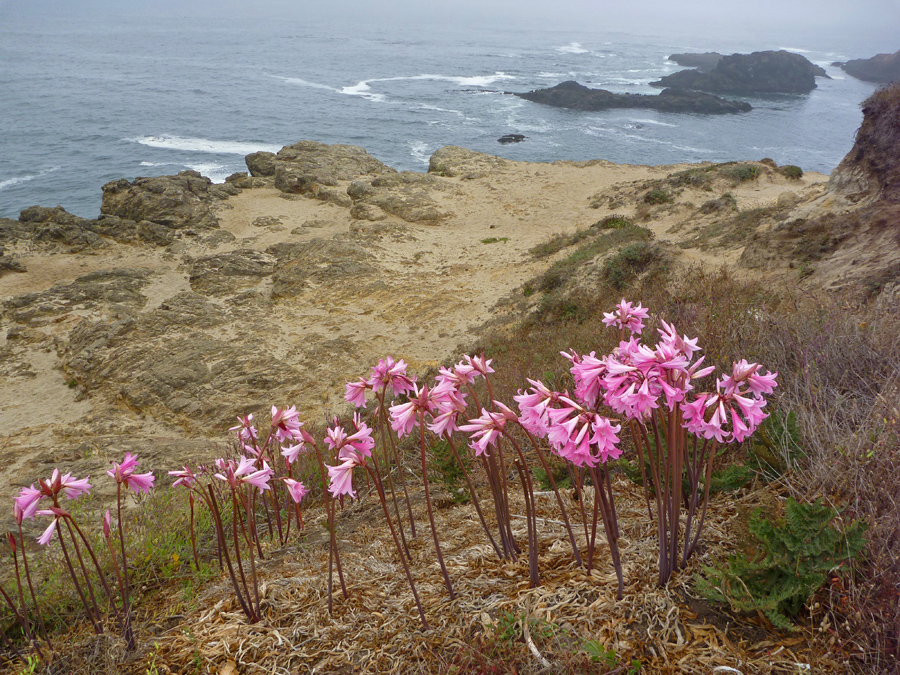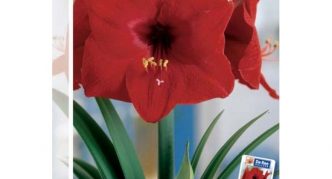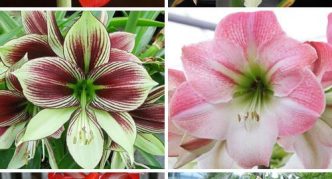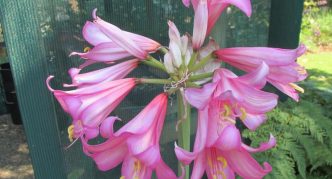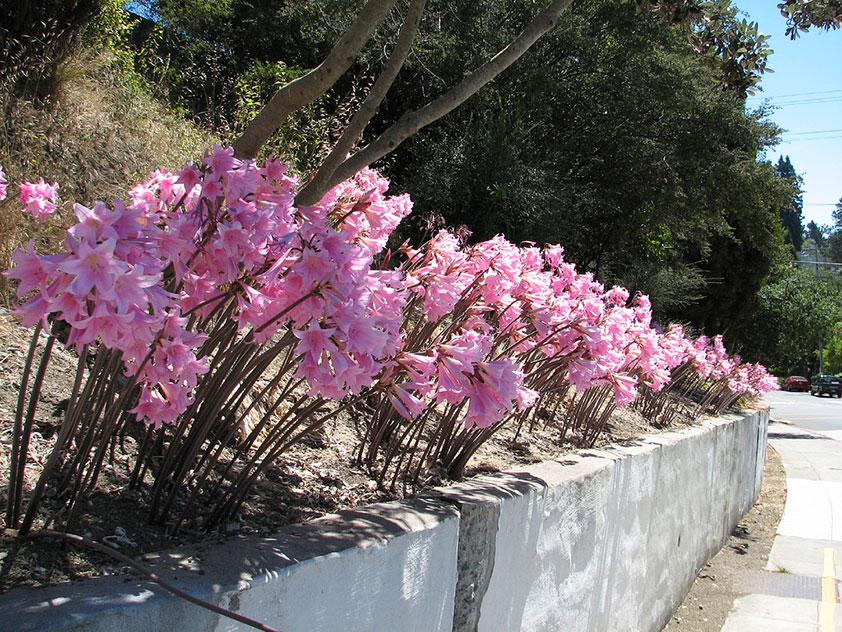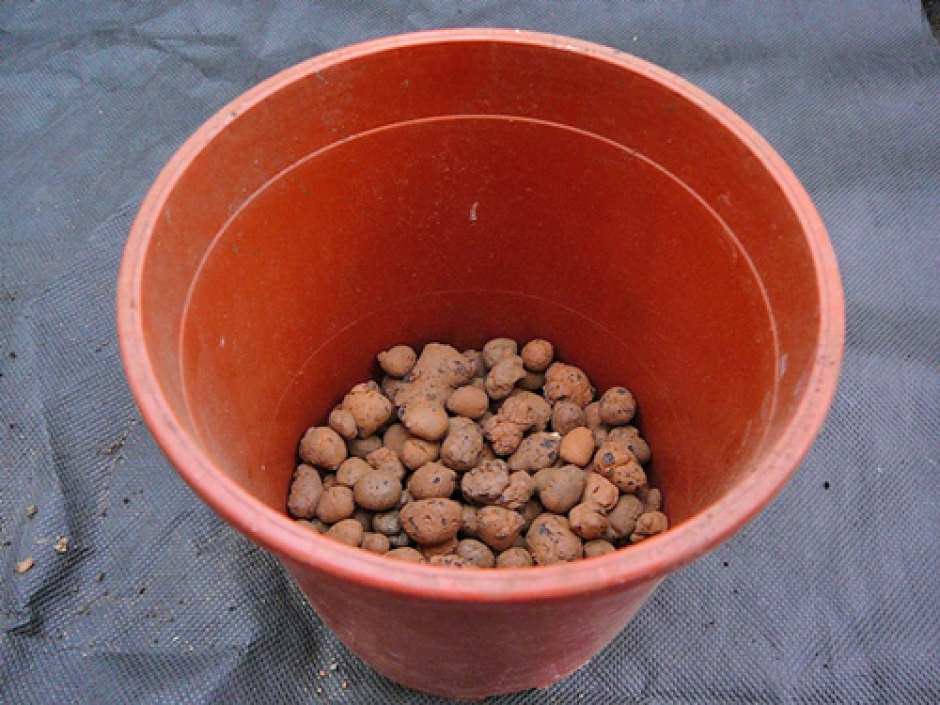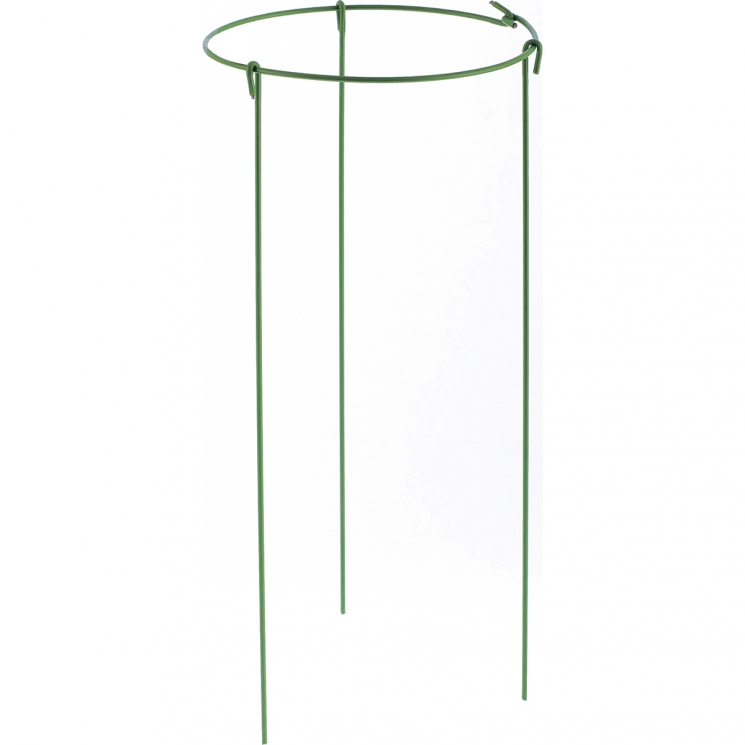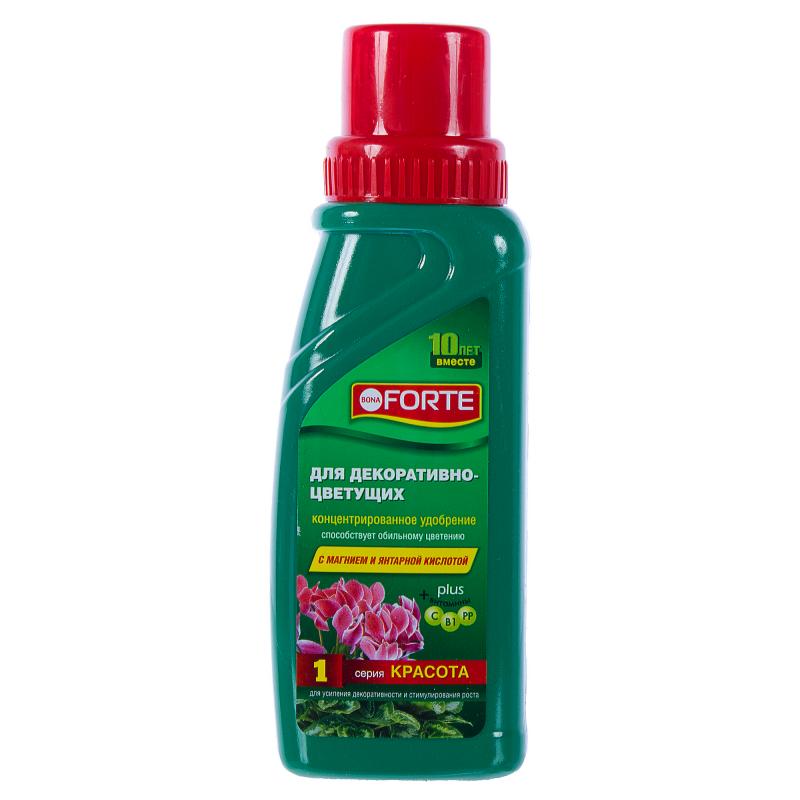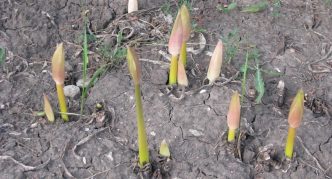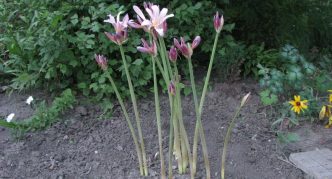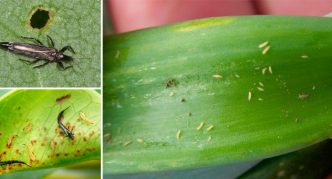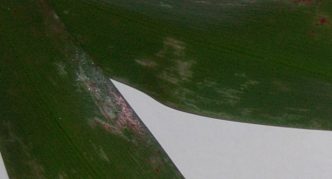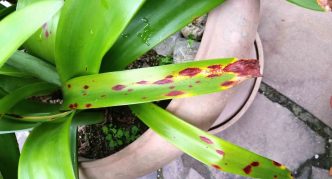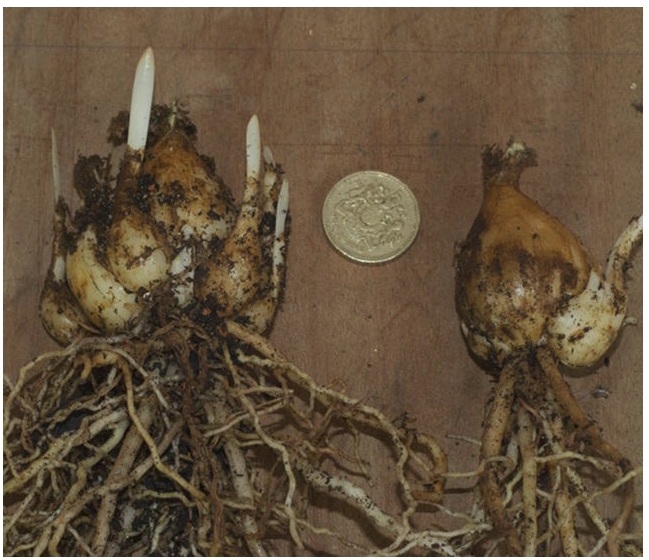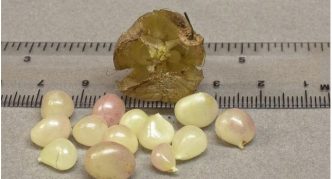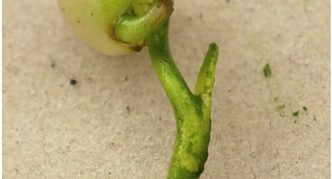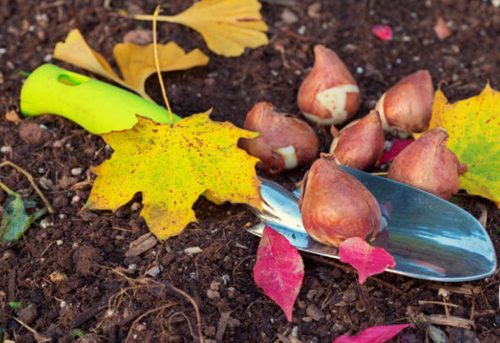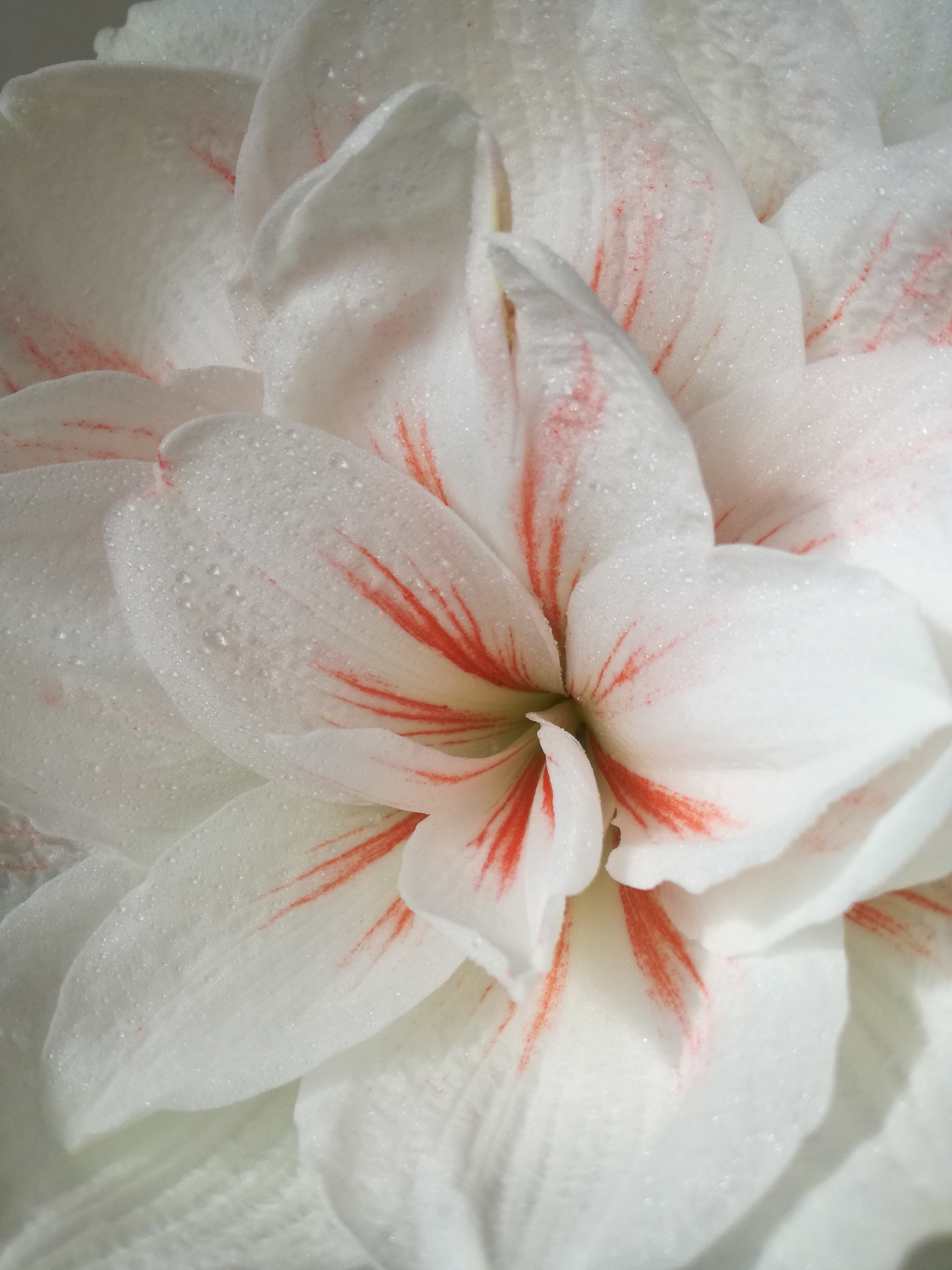Amaryllis is often confused with its closest relative, hippeastrum, but these plants differ in both varieties and flowering. A real amaryllis belladonna is a very rare guest on the windows of apartments, and even those who have found a rare bulb, after a few years give them to other hands, since most often it does not bloom in an apartment. To provide a flower with good care at home, you need to make a lot of effort and time.
Content
The origin of the amaryllis
The amaryllis was discovered by the Swedish scientist Karl Linnaeus, and it happened in 1753 in the Cape province of South Africa.
Amaryllis is a perennial bulbous plant, an adult bulb can grow up to 10 cm in diameter. In nature, flowering occurs at the end of summer. It blooms in a leafless state, releasing a bare peduncle up to 60 cm high. At the end of it there is an inflorescence with funnel-shaped flowers. Most often, from 2 to 12 flowers of pink color bloom, but recently white flowers have also begun to be found.
Around the same time, on another continent - in South America, hippeastrum were discovered and brought to Europe, which became the favorites of many gardeners.
For a long time, collectors and sellers called hippeastrum amaryllis, and only in 1987 at the International Congress of Botanists they were expelled from the genus Amaryllis and now they form their own genus Hippeastrum.

Hippeastrum was found in South America and is similar to amaryllis, but leaves and flowers appear at the same time.
Table: how to distinguish amaryllis from hippeastrum
| Distinctive feature | Amaryllis | Hippeastrum |
| Ease of purchase | It is very difficult to find, most often in collections, as in stores called "amaryllis" they sell hippeastrum | Sold in almost any store as bulbs or flowering plants |
| Number of species | One | Up to 85 |
| Place of origin | South Africa | South America |
| Dormant period | Has a period of complete withering away of leaves | Available in only a few species |
| Bloom | 1 time at the end of summer | 1-2 times a year |
| Peduncle | Dense | Hollow |
| Color of flowers | White and various shades of pink | From white to burgundy, with stripes, dots, border |
| Leaves | Narrow, smooth | Belt-shaped, long |
| Bulb | Pear-shaped | Rounded |
| Child education | Abundant | Most often poor |
| Smell of flowers | Strong aroma | Absent |
Indoor types and varieties of flowers
For a long time, the only representative of the amaryllis species was considered to be amaryllis belladonna with a color of flowers from pale pink to deep purple. But in 1998, a closely related plant was found in the more arid and mountainous areas of Africa, calling it Amaryllis paradisicola.
The new species was distinguished by wider leaves and the number of flowers in the inflorescence (up to 21), in addition, the color of the flowers was uniformly pink.
Both species have a strong aroma, but the paradisicola is much richer.
Amaryllis belladonna was cultivated in the 1700s, it was exported to Europe, America and Australia, where much later it was crossed with Crinum and Brunswigia. The resulting hybrids have a variety of colors, including stripes and veins and lighter corolla centers.
Types and varieties of amaryllis and hippeastrum in the photo
- One of the examples when the manufacturer incorrectly named hippeastrum amaryllis
- Both pink and white amaryllis exist in nature.
- The color and shape of hippeastrum flowers can vary significantly.
- Amaryllis paradiscola - opened in 1998, has a strong aroma and a large number of buds
Table - conditions of detention
| Conditions | Dormant period | Growing season |
| Lighting | Does not need | Direct sunlight, bright diffused light |
| Watering | Absent | Moderate |
| Temperature | About 100C | 22–240FROM |
| Top dressing | Does not need | 1 time in 2 weeks with mineral or organic fertilizers |
Planting and transplanting amaryllis
Since amaryllis bulbs cannot overwinter even at minimal negative temperatures, it is better to grow the plant in pots. However, in the southern regions of Russia, in the Krasnodar Territory, it is also planted in the ground.
Pot selection
The diameter of the pot for amaryllis should be 4–5 cm larger than the diameter of the bulb itself, that is, when planting from the bulb to the wall of the pot, it should be about 2 cm. The same rule should be followed when transplanting grown plants into a larger pot.
It is better to take the pots themselves high, stable, and for group plantings of several bulbs - large pots. Since the plant produces an abundant number of children, group planting is preferable.
Soil selection
Amaryllis is undemanding to the soil - any purchased land with neutral acidity will do, however, for better air exchange per 10 liters of earth, it is better to add 2-3 liters of coconut substrate and 1 liter of vermiculite.
Since most often amaryllis belladonna is sold in bulbs, and not in flowering plants, they are planted in soil or pots.
Landing
- We pour 2-3 cm of drainage at the bottom of the pot, it is best to use modern material - expanded clay.
- We fill the pot with soil so that the top of the bulb is slightly above the level of the walls of the pot.
- We put the onion and cover it with soil, 1-2 cm short of the edge of the pot for easy watering.
- Lightly crush the soil around the onion, spill it with water.
In hot climates with very warm winters, where the temperature does not drop below +100C, amaryllis are planted in the ground so that the entire bulb is submerged in the soil, then the flower stalks come out of the bare ground.
Attention, all operations with planting, transplanting, pruning or treating amaryllis bulbs should be carried out only with gloves, since the secreted juice is poisonous.
Do I need support
Flowers growing in the ground do not need support. When planting bulbs in pots, especially if the bulb is not completely submerged in the ground, sometimes supports must be placed to support the peduncle. With a lack of light, the leaves can also be frail and fall apart, they can be collected using circular supports.
Caring for amaryllis at home
Amaryllis is a very rare and exotic plant, caring for it is somewhat difficult.
Watering and feeding during cultivation
The growing season of amaryllis begins with the release of a flower arrow at the end of summer, emerging from the bare ground, the peduncles grow rapidly upward and soon bloom. At this time, watering is needed abundant, you should also feed the amaryllis with fertilizers for flowering plants.
Leaves appear soon, but if it is cold, then this period can last until April, but already at the end of spring the leaves die off and the bulb gathers strength for flowering. The period of leaf growth is a very important stage, because at this time flower stalks are formed and nutrients are collected, so you need to fertilize every 2 weeks.
Flowering period
Unlike hippeastrum, making true amaryllis bloom is not easy. In the ground, it blooms itself, but in pots purchased bulbs are not always in a hurry to show the arrow. Even with leaves it grows reluctantly. However, it is believed that if a plant spends the summer in a hot garden in the sun, then with the onset of winter it will definitely bloom.
After flowering, a bulb with seeds may form, and most often leaves appear. Seeds can be collected and planted to produce new plants, the peduncle is broken out or cut, and the plant itself is well fed.
Photo gallery - amaryllis bloom in a private garden in the Krasnodar Territory
- At the end of summer, amaryllis flower stalks appear directly from the ground
- Peduncles grow quickly, doubling their height per day
- Soon the first flowers begin to bloom
- Blooming amaryllis
Video - flowering amaryllis in the garden, caring for a plant in the open field
https://youtube.com/watch?v=Zc4NZM6DaMw
Dormant period
In the conditions of apartment maintenance, there is little reliable information about the dormant period: most often it is recommended to keep the bulb at a temperature of + 10 + 120From until the leaves appear, without watering, fertilizing, and even without light. However, the calendar winter months fall on the growing season of the amaryllis, so the temperature should be + 22 + 240C with a day length of 12-14 hours.
Flowers behave in a completely different way in the garden: after flowering at the end of summer, they can go to sleep until April, without releasing a single leaf. And already with the arrival of warm days, leaves come to life and grow.
Like many other bulbous plants, amaryllis do not form: they do not pinch or prune.
Table - problems with growing and how to solve them
| Errors | How to fix |
| Does not bloom | To give the plant a good rest in the summer, preferably in the sunniest and warmest place, it is best to plant it in the ground |
| New bulb does not produce leaves | If the planting was in spring, then wait for the end of summer, when, in natural conditions, the plant begins to grow and bloom. When planting in the fall, be patient. |
Table - diseases and pests of the amaryllis family
| Disease / pest | Description | Solution to the problem |
| Red burn (stagonosporosis) | A very dangerous disease, manifested in the appearance of red spots on the bulb, leaves, often leads to the death of the plant | Cutting out damaged parts of the bulb to living tissue, followed by air drying and disinfection. As a preventive measure, treat each new purchased onion with Maxim |
| Gray rot | The appearance of brown soft spots on the bulb, loss of leaf elasticity | Remove and inspect the bulb for rot. Cut out damaged areas, treat with brilliant green and dry in the shade for 24–48 hours. Plant in fresh soil, monitor the frequency of watering |
| Thrips | Small thin insects are visible on the underside of the leaves, and dry white areas on the leaf surface | Treatment with Fitoverm with repeated spraying after a week |
Photo gallery - flower diseases and pests
- Thrips on leaves
- Red burn on the bulb of the hippeastrum
- Leaf damaged by thrips
- Wet covering scales of this brown color indicate rotting of the bulb.
- Cured onion after processing with greenery
- Red burn on the leaves of the hippeastrum
Reproduction
An adult bulb gives a lot of babies, therefore, it forms beautiful thickets in wildlife. For reproduction, it is enough to separate the baby from the mother plant and plant it separately. Such a baby will bloom in 3-4 years.
Unlike hippeastrum, after flowering, amaryllis forms a seed capsule with bulbs, which, after the peduncle dries, also sink to the ground and germinate. However, in indoor conditions, flowering is very rare.
It is considered inappropriate to propagate amaryllis by dividing the bulb, since it gives a lot of children. It is better to plant and divide the plant after the end of the growing season.
Photo gallery - seed formation of amaryllis belladonna
- Amaryllis seeds in a seed box
- White bulb-seeds
- Bulb germination
Reviews
Until recently, I thought that I was growing hippeastrum on my windowsill. Until I saw a flower very similar to mine, it was called amaryllis for some reason. And I decided to find out for myself what grows on my windowsill really?
It turns out that these two flowers are very similar to each other, and an inexperienced person can hardly distinguish them purely in appearance. But there are still differences. They are often confused because both have large bulbs that throw out thick peduncles of funnel-shaped flowers. Amaryllis is more rare; and the plant we usually buy called amaryllis is actually hippeastrum. The important difference is that, firstly, this is the flowering time. Hypeastrum blooms somewhere from late winter to spring, and amaryllis, around late summer and autumn. Secondly, unlike the amaryllis, the flower arrow of the hippeastrum is hollow and, therefore, is not able to withstand many flowers, therefore there are rarely more than four or five of them on this flower, the arrow of the amaryllis is fleshy and there may be more flowers. Thirdly, amaryllis flowers have a pleasant aroma, and hippeastrum is odorless. Fourthly, hypeastrum, unlike amalilis, form daughter bulbs much less often. But hippeastrum is still more common in our country, unlike its twin brother. There are other differences and who is interested in what actually grows in them. , if they wish, they can find out. Therefore, in order to really buy amaryllis, and not hippeastrum bulbs, it is better to buy in specialized stores.
I planted my onions in pots in mid-May and planted them in the garden in the open ground, where they sat with me until the end of August and did not give any signs, and then I started laying a new compost and watered each layer with Baikal-EM, and so I applied the remaining (a little) part of the watering preparation on the Amaralis bows and after a week they showed leaves. Then after 2 weeks I watered (again a little) minerl. fertilizer 8-8-8 NPK and they went with joy in growth, but so far only leaves. And now at night it became +8 and I passed into other pots and brought it into the house and put it in the place where +20, I water it a little through the pallet and there a few drops of NK 3.4-6.8.
You saw a photo of amaryllis belladonna on the internet, right? Beautiful pink narrow-petaled flowers. There are such flower forms among hippeastrum, yes.But among precisely the amaryllis belladonna, which is sometimes sold in flower shops, there are no white ones with a green throat. In general, from my experience and the experience of our forum, amaryllis belladonna at home (i.e. when grown in a pot) did not bloom in anyone. On the street - yes, in the east of France, the girl showed amaryllis thickets. He hibernates there in the ground. Perhaps, somewhere on the coast, amaryllis also grows and blooms, I didn’t track much :), but after three years of torment (both myself and the Eva: D), I refused. At home, it is very difficult, almost impossible, to achieve flowering from amaryllis belladonna. (therefore, it is also a rarity in online stores, and the price for hippeastrum is adjusted, although generally amaryllis belladonna, as a species, is cheaper than varietal hippeastrum). Hence the conclusion - hippeastrum are widespread in our country, not amaryllis, because it is much easier to get flowers from them. And in Internet stores, varietal hippeastrum is often called amaryllis, it is believed in the west that this name is prettier: D. Well, on a note - distinguishing hippeastrum from amaryllis, even sleeping, is as easy as shelling pears. Tear off a scale (you can dry it, you can even have a leaf), if the veins-strings follow, this is amaryllis. Nothing stretches behind the leaf scales of the hippeastrum.
Amaryllis belladonna is so far the only representative of amaryllis in indoor floriculture. However, due to the confusion that occurred in the 1700s and continues to this day, hippeastrums are often called amaryllis, although they were singled out in their own genus back in 1998. Amaryllis very rarely bloom indoors, but in southern Russia and in Europe, in countries with warm winters, they are very common and grow in gardens and parks.
